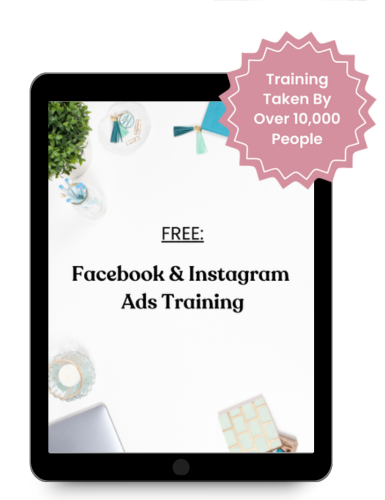Your lead magnet is your business's front door—but if it's attracting window shoppers instead of serious buyers, you're setting yourself up for disappointing launches and crickets in your inbox. Here's the truth that most course creators don't want to hear: not all leads are created equal, and in today's saturated market, quality trumps quantity every single time.
If you've been wondering why your email list feels dead, why your launches fall flat, or why people download your freebie and then disappear into the digital void, this comprehensive lead magnet audit will give you the answers you need.
Estimated reading time: 13 minutes
💡 Want the full picture? This article goes hand-in-hand with Episode 314: Stop Chasing $1 Leads—Here’s What to Do Instead
Pop in your earbuds and get the deeper dive.
👉 [Listen to the companion episode here]
Why Your Lead Magnet Quality Matters More Than Ever
The online education space has exploded, with the global e-learning market projected to reach $1 trillion by 2027. But here's what that growth really means for course creators: your audience has more options than ever before. They're not just comparing you to your direct competitors—they're comparing you to every piece of free content they can find on YouTube, every podcast they listen to, and every social media guru promising quick fixes.
This shift has created what industry experts call the “trust recession“—a phenomenon where potential customers are more skeptical than ever about investing in online courses. Your lead magnet isn't just competing for attention; it's your first opportunity to build the trust that will eventually lead to a sale.
The problem with most lead magnets? They're designed to cast the widest possible net, attracting anyone and everyone who might be remotely interested in your topic. But here's what happens when you optimize for quantity over quality:
- Your email open rates plummet because your list is full of people who aren't genuinely interested
- Your launch conversion rates stay frustratingly low (often under 1%)
- You waste time and money nurturing leads who will never buy
- Your messaging becomes diluted trying to speak to everyone
The solution isn't to create more lead magnets—it's to create buyer magnets: lead magnets specifically designed to attract people who are ready to invest in transformation, not just collect another PDF.
The 7-Point Lead Magnet Quality Check
This audit will help you evaluate whether your current lead magnet is attracting qualified prospects or just digital hoarders. Each point builds on the last, creating a comprehensive framework for lead magnet optimization that actually drives conversions.
Point #1: Does Your Lead Magnet Solve a Problem That Leads to Your Paid Offer?
What to look for: Your lead magnet should address a smaller version of the big problem your course solves.
The most effective lead magnets create what marketing strategists call a “logical next step.” When someone uses your freebie and gets results, they should naturally think, “If this free thing helped me this much, imagine what their paid program could do.”
The Quality Check:
- Does your freebie directly connect to your main offer?
- Would someone who uses your lead magnet naturally want more help?
- Is there a clear progression from free to paid solution?
✅ Good Example:
- Course topic: How to launch a profitable online business
- Lead magnet: “The Pre-Launch Checklist: 15 Things to Do Before You Launch”
This works because someone using the checklist will inevitably realize they need help with the actual launch process—exactly what the course provides.
❌ Poor Example:
- Course topic: How to launch a profitable online business
- Lead magnet: “50 Social Media Post Ideas for Entrepreneurs”
While this might attract entrepreneurs, it doesn't create desire for launch-specific help. Someone could use all 50 post ideas and still have no interest in learning about business launches.
Red Flag: If your lead magnet feels disconnected from your main offer, you're attracting people who want that specific freebie—not your transformation.
Point #2: Does It Attract People Ready to Invest (Not Just Learn)?
What to look for: Language and positioning that speaks to people who are solution-focused, not just information-hungry.
There's a crucial difference between people who want to learn about something and people who want to change something. Your lead magnet should attract the latter—people who are actively trying to solve a problem, not just satisfy curiosity.
The Quality Check:
- Does your headline use action-oriented language?
- Are you promising a result, not just knowledge?
- Would someone already taking action in this area want this?
✅ Good Example: “The 3-Day Energy Reset: How to Ditch Afternoon Slumps Without More Coffee”
This attracts people actively trying to improve their health—people who are likely to invest in solutions.
❌ Poor Example: “Ultimate Guide to Understanding Your Energy Levels”
This attracts people who want to research and understand, not necessarily people ready to make changes.
Red Flag: If your lead magnet title includes words like “ultimate guide,” “everything you need to know,” or “complete beginner's guide,” you might be attracting researchers, not buyers.
Research shows that action-oriented lead magnets convert 40% better than information-only resources because they attract people who are already in a problem-solving mindset.
Point #3: Is It Specific Enough to Repel the Wrong People?
What to look for: A lead magnet that clearly defines who it's for and who it's NOT for.
This might sound counterintuitive, but the best lead magnets actually repel certain people. When you try to appeal to everyone, you end up appealing to no one with buying power.
The Quality Check:
- Would someone in a different industry or stage skip this?
- Does it use specific language that resonates with your ideal client?
- Are you okay with some people NOT downloading it?
✅ Good Example: “The CEO Scorecard: Find 5 Things Keeping You Stuck at Six Figures”
This clearly targets established business owners, not beginners. Someone making $30K annually would skip this—and that's perfect.
❌ Poor Example: “How to Make Money Online: A Beginner's Guide”
This appeals to everyone from teenagers to retirees, attracting people with vastly different needs and buying power.
Red Flag: If your grandmother, your teenager, and your business bestie would ALL want to download it, it's probably too broad.
The specificity principle works because:
- Specific language creates stronger emotional resonance
- It pre-qualifies your audience before they even opt in
- It positions you as a specialist, not a generalist
- It attracts people who are further along in their buyer journey
Point #4: Does It Require Implementation (Not Just Consumption)?
What to look for: A lead magnet that asks people to DO something, not just read something.
Passive consumption creates passive subscribers. If someone can get full value from your lead magnet without lifting a finger, you're not filtering for the action-takers who become buyers.
The Quality Check:
- Does your freebie include worksheets, templates, or action steps?
- Will someone need to invest time to get value from it?
- Does it create a micro-commitment from your audience?
✅ Good Example: “The 7-Day Launch Revenue Calculator + Planning Worksheets”
This requires them to input their numbers, think about their goals, and actively plan—creating investment and engagement.
❌ Poor Example: “10 Launch Mistakes to Avoid”
Pure information that can be consumed in 3 minutes without any action required.
Red Flag: If someone can get full value from your lead magnet in under 3 minutes of passive reading, it's not filtering for action-takers.
Why implementation matters:
- People who take action on free content are more likely to take action on paid content
- Implementation creates investment, and investment creates commitment
- It gives you insight into who's actually engaged with your content
- Action-takers have higher lifetime customer value
Point #5: Are You Getting Engagement Beyond the Download?
What to look for: Signs that people are actually using your lead magnet and finding value.
Downloads are a vanity metric. What matters is whether people are engaging with your content after they get it. This engagement is a leading indicator of conversion potential.
The Quality Check:
- Are people replying to your follow-up emails about the freebie?
- Do you get questions or feedback about the content?
- Are people sharing results or asking for next steps?
How to measure this:
- Track email replies to your lead magnet delivery sequence
- Monitor social media mentions or tags
- Look at click-through rates on your follow-up emails
- Check if people are asking questions in your DMs
Benchmark goals:
- Email open rates: 40%+ for lead magnet subscribers
- Click-through rates: 10%+ on follow-up emails
- Reply rates: 2-5% should engage with your content
Red Flag: If your lead magnet gets downloaded but generates zero conversation or questions, it's not compelling enough to drive engagement.
Pro tip: Include a specific question in your lead magnet delivery email like “What was your biggest takeaway from the calculator?” This makes it easy for engaged subscribers to respond and helps you identify your most qualified leads.
Point #6: Does It Position You as the Expert They Need?
What to look for: A lead magnet that showcases your unique methodology or approach.
Generic advice positions you as interchangeable with every other expert in your space. Your lead magnet should give people a taste of your unique approach and make them think, “I've never thought of it that way before.”
The Quality Check:
- Does it hint at your proprietary framework or system?
- Would someone say “I've never thought of it that way” after using it?
- Does it demonstrate the kind of results you help people achieve?
✅ Good Example: “The SCALE Method: My 5-Step System for Doubling Course Revenue Without Doubling Your Work”
This showcases a unique methodology and promises a specific, desirable outcome.
❌ Poor Example: “5 Ways to Market Your Course”
Generic advice that any marketing expert could provide.
Red Flag: If your lead magnet could have been created by any of your competitors, it's not establishing your unique authority.
Authority-building elements to include:
- Your signature framework or methodology
- Unique insights from your experience
- Specific results you've achieved or helped others achieve
- A fresh perspective on common problems
Point #7: Are Your Lead Magnet Downloads Converting to Sales?
What to look for: Actual data showing that people who download your lead magnet eventually buy from you.
This is the ultimate test. Everything else is just theory if your lead magnet subscribers aren't becoming customers.
The Quality Check:
- Tag everyone who downloads this specific lead magnet
- Track their journey through your launches
- Calculate the conversion rate from download to purchase
- Compare it to other lead magnets you've tried
Benchmark Goals:
- Email open rates: 40%+ for lead magnet subscribers
- Launch conversion: 2-5% of qualified leads should buy
- Engagement: 10%+ should click links in your nurture emails
How to track this:
- Use email marketing tags to segment lead magnet subscribers
- Track their behavior through your sales funnel
- Calculate conversion rates for each lead magnet
- A/B test different lead magnets to optimize performance
Red Flag: If less than 1% of people who download your lead magnet ever buy anything from you, it's attracting the wrong audience.
Advanced tracking tip: Set up conversion tracking in your email platform to automatically tag subscribers who make purchases. This gives you real-time data on which lead magnets are driving revenue, not just downloads.
Your Lead Magnet Audit Results
Count how many points your current lead magnet passes:
7/7 Points: Your lead magnet is a buyer-magnet! Focus on driving more traffic to it through SEO optimization, paid ads, and strategic partnerships.
5-6/7 Points: You're close! Pick the 1-2 failing points and optimize those first. Small tweaks can lead to significant improvements in conversion rates.
3-4/7 Points: Your lead magnet needs a refresh. Start with Points #1 and #2—ensuring problem-solution alignment and attracting investment-ready prospects.
1-2/7 Points: Time for a complete lead magnet makeover. Use this audit as your blueprint to build a new one that actually converts.
0/7 Points: This is actually great news—you now know exactly why your launches feel hard and your list doesn't convert. Time to build a lead magnet that works.
Quick Action Steps Based on Your Score
If you scored 5+ points:
- Test new headlines that are more specific (Point #3)
- Add implementation elements like worksheets or calculators (Point #4)
- Set up proper tracking for your lead-to-sale conversion rate (Point #7)
- Optimize your follow-up sequence to increase engagement
If you scored 3-4 points:
- Audit the connection between your freebie and paid offer (Point #1)
- Rewrite your copy to attract action-takers, not researchers (Point #2)
- Add your unique methodology or framework (Point #6)
- Create implementation requirements to filter for serious prospects
If you scored 0-2 points:
- Start fresh with a lead magnet that directly leads to your course
- Focus on attracting people ready to invest, not just learn
- Make it specific enough that some people will skip it
- Include action steps that require engagement
The Real Talk Wrap-Up
Your lead magnet isn't just a freebie—it's your first sales tool. It should attract people who are ready to invest in transformation, not just collect another PDF.
A lead magnet that passes this 7-point audit will:
✅ Fill your list with engaged, qualified prospects
✅ Make your launches feel easier and more profitable
✅ Turn your email list into your most valuable business asset
Remember: It's better to have 100 qualified leads who open every email and buy your offers than 1,000 freebie-seekers who ghost you the moment you mention price.
The course creators who are thriving in 2024 and beyond aren't the ones with the biggest lists—they're the ones with the most engaged, qualified subscribers. Your lead magnet is the foundation of that quality.
Frequently Asked Questions
Q: What's the difference between a lead magnet and a buyer magnet?
A: A lead magnet is designed primarily to capture email addresses from anyone interested in your general topic. A buyer magnet is strategically designed to attract people who are ready to invest in solutions, not just collect free information. Buyer magnets use specific language, require implementation, and directly connect to your paid offers.
Q: How do I know if my lead magnet is attracting qualified leads?
A: Look at these key metrics: email engagement rates (40%+ opens), click-through rates on follow-up emails (10%+), replies and questions about your content (2-5%), and most importantly, conversion rates from lead magnet to paid offers (2-5% for qualified audiences).
Q: What formats work best as lead magnets for online courses?
A: The most effective formats for course creators include: calculators and assessment tools, checklists and templates, mini-courses or video series, case studies with specific results, and planning worksheets. The key is choosing a format that requires implementation, not just consumption.
Q: How often should I audit my lead magnets?
A: Conduct a comprehensive audit every 6 months, or immediately if you notice declining email engagement or conversion rates. Also audit whenever you launch a new course or significantly change your target audience.
Q: Can I have multiple lead magnets for the same course?
A: Yes, but each should target a different segment of your audience or stage of awareness. For example, you might have one lead magnet for beginners and another for people already taking action. Just ensure each one passes the 7-point quality check.
Q: What's a good conversion rate from lead magnet to paid course?
A: For qualified leads, aim for 2-5% conversion during launches. If you're converting less than 1%, your lead magnet is likely attracting browsers rather than buyers. Industry data shows that highly targeted lead magnets can achieve conversion rates of 8-12%.
Q: How long should my lead magnet be?
A: Length matters less than value and implementation requirements. A one-page calculator that requires 15 minutes of input is more effective than a 50-page guide that can be skimmed in 5 minutes. Focus on creating something that demands engagement, regardless of length.
Q: Should I gate my best content as a lead magnet?
A: Not necessarily. Your lead magnet should be valuable enough to build trust but strategic enough to create desire for more. Save your absolute best content for your paid offers, but make sure your lead magnet gives a genuine taste of your expertise and approach.
Ready to transform your lead magnet into a buyer magnet? Start with Point #1 of this audit and work your way through each element. Your future self (and your bank account) will thank you.
Want the full breakdown on why chasing $1 leads is costing you sales and what to focus on instead? Listen to Episode 314 of The Launch Lounge Podcast: “Stop Chasing $1 Leads—Here's What to Do Instead.”
Know a course creator whose lead magnet is attracting browsers instead of buyers? Forward them this audit—you'll be their hero.
Want more actionable marketing strategies? Tune into our podcast for weekly insights on scaling your online course business with Facebook and Instagram ads that work. Listen on Apple – Spotify – YouTube










